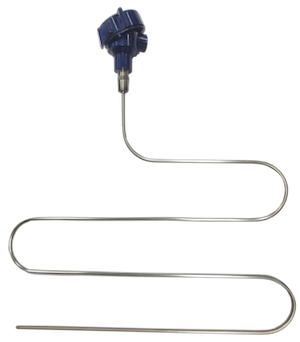
When it comes to HVAC temperature measurements, a single point sometimes is not enough. An averaging RTD measures temperature along a duct or across a sectional area, resulting in more accurate information about the overall conditions inside HVAC units.
Resistance temperature detectors (RTDs) are commonly found in ducts and heat exchangers to help HVAC equipment run more efficiently. However, when such units have only a single-point temperature sensor, operators run the risk of not seeing the bigger picture. One spot may run significantly hotter or cooler than others, or the air inside a duct could be stratified.
What Does an Averaging RTD Do?
To get a better picture of the overall temperature inside a duct or heat exchanger, users can install an averaging RTD along its length or across a section.
An averaging RTD has long, flexible strips of sheathed platinum wires that can be bent and coiled into any configuration. Its Pt100 sensor measures temperature along the entire length of the wires, which minimizes the risk of getting a too-hot or too-cold reading in gas compressors, air exchangers, and HVAC assemblies.
Highly Customizable Averaging RTD sensors

Averaging RTD sensor
WIKA’s averaging RTD sensorsare extremely versatile. They measure a wide temperature range – from −40°F to +392°F (−40°C to +200°C) – and can be customized to suit almost every HVAC application.
The standard lengths are 4′ (1.2m), 7′ (2.1m) and 15′ (4.6m), but the factory can trim them to customers’ exact specification. The sensors are sheathed in a flexible armor made of 316 stainless steel, which means they can be inserted directly into the process. They have ingress protection and FM (FM Global) and CSA (Canadian Standards Association) approval for use in explosion-proof hazardous locations.
The 3-wire or 4-wire configuration offers different levels of accuracy, precision, and repeatability. The sensors can come with or without a connection head. An optional Crastin terminal block reduces the risk of loose connections.
WIKA’s averaging RTDs come in a direct mount (TR10) or remote mount (TR15) version. The TR15 can be fitted with an up to 100′ (30.5m) armored extension to reach deeper into an HVAC unit. This model also has the option of a digital programmable transmitter to convert the resistance output signal.
Mounting is simple: Just secure the averaging RTD with clips or tie wires. Replacements are similarly hassle-free, as customers can order just another sensor without having to buy another terminal head as well.
For more information about whether an averaging RTD sensor is right for your industrial HVAC applications, contact the temperature measurement experts at WIKA USA.

